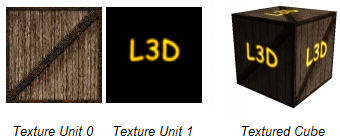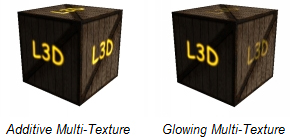3차원 그래픽에서 특수 효과는 쉐이더를 통해 대부분 구현됩니다. 이 글은 간단한 GLSL 쉐이더 코드를 통해 물과 불에 대한 효과를 소개합니다.
먼저 불에 대해 구현하고자 하는 모습은 다음과 같습니다.
다음은 물에 대한 결과입니다.
전체 소스코드는 아래 링크를 통해 다운로드 받으실 수 있습니다. 웹기반에서 구현된 코드이므로 js와 css, html 파일로 구성되어 있으며 WebGL 2.0으로 쉐이더 코드가 실행됩니다.

공간정보시스템 / 3차원 시각화 / 딥러닝 기반 기술 연구소 @지오서비스(GEOSERVICE)
원문 : http://www.lighthouse3d.com/opengl/glsl/index.php?textureMulti
멀티 텍스쳐링은 GLSL에서는 정말 쉽다. 해야할 것은 두개의 텍스쳐에 접근하는 일이 전부다. 그리고 이 장에서는 동일한 텍스쳐 좌표를 사용할 것이기 때문에 버텍스 쉐이더를 재작성하지 않고 이전 강좌의 것을 그대로 사용한다. 프레그먼트 쉐이더 또한 두개의 텍스쳐 색상을 추가하는 최소한의 변화만 있다.
varying vec3 lightDir,normal;
uniform sampler2D tex,l3d;
void main()
{
vec3 ct,cf;
vec4 texel;
float intensity,at,af;
intensity = max(dot(lightDir,normalize(normal)),0.0);
cf = intensity * (gl_FrontMaterial.diffuse).rgb +
gl_FrontMaterial.ambient.rgb;
af = gl_FrontMaterial.diffuse.a;
texel = texture2D(tex,gl_TexCoord[0].st)+
texture2D(l3d,gl_TexCoord[0].st);
ct = texel.rgb;
at = texel.a;
gl_FragColor = vec4(ct * cf, at * af);
} 그리고 이제, 약간 다른 특별한 것을 해보자: Glow in the Drak Effect. 이 특별한 효과는 두번째 텍스쳐를 어둠속에서 타오르는듯하게 보이는 것이다. 예를들어, 완전이 밝아졌다가 어두워지는 듯한 효과.
그리고 이제, 약간 다른 특별한 것을 해보자: Glow in the Drak Effect. 이 특별한 효과는 두번째 텍스쳐를 어둠속에서 타오르는듯하게 보이는 것이다. 예를들어, 완전이 밝아졌다가 어두워지는 듯한 효과.
 두 단계로 최종 색상을 다시 계산해야 하는데, 먼저 첫번째 텍스쳐를 프레그먼트 색상으로 조정된 상태의 색상을 계산하고, 이후에 두번째 텍스쳐 유닛을 강도에 기반해서 추가하는 것이다.
두 단계로 최종 색상을 다시 계산해야 하는데, 먼저 첫번째 텍스쳐를 프레그먼트 색상으로 조정된 상태의 색상을 계산하고, 이후에 두번째 텍스쳐 유닛을 강도에 기반해서 추가하는 것이다.
intensity가 0이라면, 두번째 텍스쳐가 전체적으로 완전하게 표시된다. 반대로 intensity가 1이라면, 두번째 텍스쳐를 10% 정도만 표시되도록 한다. 이런 표시를 위해 smoothStep라는 함수를 통해 구현할 것이다. 이 함수의 시그니쳐는 다음과 같다.
genType smoothStep(genType edge0, genType edge1, genType x);만약 x<=edge0이면 결과는 0이고, x>=edge1이면 1 그리고 edge0< x <edge1이면 Hermit 보간 연산이 수행된다. 우리의 경우 다음 함수를 호출한다.
coef = smoothStep(1.0, 0.2, intensity);다음은 프레그먼트 쉐이더 코드이다.
varying vec3 lightDir,normal;
uniform sampler2D tex,l3d;
void main()
{
vec3 ct,cf,c;
vec4 texel;
float intensity,at,af,a;
intensity = max(dot(lightDir,normalize(normal)),0.0);
cf = intensity * (gl_FrontMaterial.diffuse).rgb +
gl_FrontMaterial.ambient.rgb;
af = gl_FrontMaterial.diffuse.a;
texel = texture2D(tex,gl_TexCoord[0].st);
ct = texel.rgb;
at = texel.a;
c = cf * ct;
a = af * at;
float coef = smoothstep(1.0,0.2,intensity);
c += coef * vec3(texture2D(l3d,gl_TexCoord[0].st));
gl_FragColor = vec4(c, a);
}